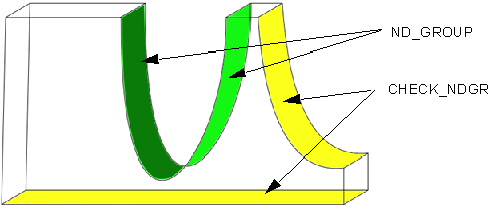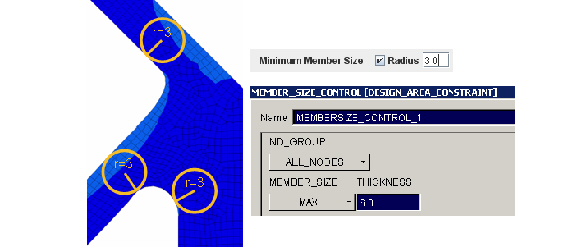| Applicable for |
Controller (SHAPE_CONTROLLER) |
Sensitivity (SHAPE_SENSITIVITY) |
| CHECK_MAX_MEM |
OK |
- |
| CHECK_MAX_MEM |
OK |
- |
For the definition of minimum member size a radius is specified, such that normal to the surface
of the model a minimum thickness of 2*radius must be achieved. If optimization displacements
break this restriction, they will be readapted according to the selected main criterion. If the
structure is smaller in certain regions from the very first, only growth is permitted in these
areas unless the areas fit the condition. CHECK_MAX_MEM works analogously.
A typical parameter set for the member size restriction is of the
following form:
DVCON_SHAPE
ID_NAME = ...
ND_GROUP = <member_size_nodes>
CHECK_MAX_MEM = <member_size_radius>
CHECK_MIN_MEM = <member_size_radius>
CHECK_NDGR = <member_size_check_group>
TOLERANCE = <tolerance_for_intersection_tests>
END_
Technically the implementation is based on the surface of the finite elements of the design
nodes. The member size is calculated as the distance between a node and the intersection point in
the negative normal direction to an element surface. If no element surface is intersected, the
member size is ignored for this node.
The ND_GROUP parameter specifies the node group that
is modified by the algorithm. This group should be a subset of the mesh smooth
area. The distance of the nodes in this group is tested against the
node group specified by CHECK_NDGR. This is an optional
parameter and set by default to <MEMBER_SIZE_NODES>.
This option is useful if the member size shall only be tested against
certain regions like shown in the following figure.
The TOLERANCE parameter is important for intersection
tests: If the intersection test for one node misses the border of
the <MEMBER_SIZE_CHECK_GROUP> slightly, the
element faces can be extended by the TOLERANCE value
(in absolute units) so that the intersection test succeeds and the desired
member size for this node is not ignored. However a too large TOLERANCE
value implies the risk of getting incorrect distances. This parameter
is optional and the default value is 0.1 * max element length.

|
Note:
-
If your initial model does not fulfill your desired member size, the
member size restriction is unable to fit the model to these values.
- If you want to ensure the minimum (maximum) member
size restriction for a certain region that is not necessarily part of the mesh smooth area,
choose all surface nodes of this region as
CHECK_NDGR. Areas that already
fulfill your restriction and are not influenced by the optimization can be left out.
- The minimum member size restriction tends to be
nonconservative. This means that the resulting member size is possibly smaller than the
desired one. A workaround is to give a higher desired minimum member size value.
- For the same reason, the maximum member size tends to be conservative.
- The member size restrictions are not yet available for sensitivity-based shape optimization.

